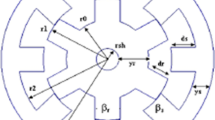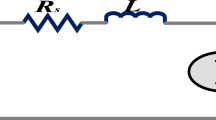Abstract
Switched reluctance motors have a rugged construction which makes them suitable for many applications. But, high torque ripple, vibration, and acoustic noise are the main drawbacks of them. In this paper, the vibration is considered in optimization besides the other desired considerations. The radial force is the main origin of vibration in switched reluctance motor, and a torque-to-force ratio is introduced for considering the low vibration in optimization. Also, modeling of switched reluctance motor is somehow challenging. In this paper, a hybrid method based on analytic and adaptive-neuro-fuzzy inference system methods is presented for modeling SRM and the obtained static characteristics are used in a dynamic simulation method. Discussion on simulation results is presented at the final part of the paper which shows the lower vibrations lead to bigger air gap length; so, to prevent the deterioration of other features, an optimization should be done. A multi-objective particle swarm optimization is used to find the dominant design, and the best design is obtained by means of weighted cost functions.








Similar content being viewed by others
References
Alotto P, Barcaro M, Bianchi N, Guarnieri M (2011) Optimization of interior PM motors with machaon rotor flux barriers. IEEE Trans Magn 47(5):958–961
Becerra RC, Ehsani M, Miller TJE (1993) Commutation of SR motors. IEEE Trans Power Electron 8(3):257–263
Boroujeni ST, Haghparast M, Bianchi N (2015) Optimization of flux barriers of line-start synchronous reluctance motors for transient-and steady-state operation. Electr Power Compon Syst 43(5):594–606
Chai JY, Lin YW, Liaw C (2006) Comparative study of switching controls in vibration and acoustic noise reductions for switched reluctance motor. IEE Proc Electr Power Appl 153(3):348–360
Cheng H, Chen H, Yang Z (2015) Design indicators and structure optimisation of switched reluctance machine for electric vehicles. IET Electr Power Appl 9(4):319–331
Ding W, Liang D (2008) Modeling of a 6/4 switched reluctance motor using adaptive neural fuzzy inference system. IEEE Trans Magn 44(7):1796–1804
Ding W, Liang D (2010) A fast analytical model for an integrated switched reluctance starter/generator. IEEE Trans Energy Convers 25(4):948–955
Ding W, Liu Y, Hu Y (2014) Performance evaluation of a fault-tolerant decoupled dual-channel switched reluctance motor drive under open-circuits. IET Electr Power Appl 8(4):117–130
Duan Y, Harley RG, Halbetler TG (2009) Comparison of particle swarm optimization and genetic algorithm in the design of permanent magnet motors. In: IEEE 6th international power electronics and motion control conference, IPEMC’09, Wuhan
Erdeljan A, Capko D, Vukmirovic S, Bojanic D, Congradac V (2014) Distributed PSO algorithm for data model partitioning in power distribution systems. J Appl Res Technol 12:947–957
Ferrari M, Bianchi N, Doria A, Fornasiero E (2015) Design of synchronous reluctance motor for hybrid electric vehicles. IEEE Trans Ind Appl 51(4):3030–3040
Garcia-Amorós J, Molina B, Andrada P (2012) Modelling and simulation of a linear switched reluctance force actuator. IET Electr Power Appl 7(5):350–359
Hasegawa Y, Nakamura K, Ichinokura O (2012) A novel switched reluctance motor with the auxiliary windings and permanent magnets. IEEE Trans Magn 48(11):3855–3858
Hashemi Z, Mardaneh M, Shasadeghi M (2012) High performance controller for interior permanent magnet synchronous motor drive using artificial intelligence methods. Sci Iran Trans D Comput Sci Eng Electr Eng 19(6):188–1793
Hu Y, Song X, Cao W, Ji B (2014) New SR drive with integrated charging capacity for plug-in hybrid electric vehicles (PHEVs). IEEE Trans Ind Electron 61(10):5722–5731
Krishanan R (2001) Switched reluctance motor derives, modeling, simulation, analysis, design, and applications. CRC Press, Boca Raton
Lachman T, Mohamad TR, Fong CH (2004) Nonlinear modelling of switched reluctance motors using artificial intelligence techniques. IEE Proc Electric Power Appl 151(1):53–56
Lecointe J, Romary R, Brudny J, McClelland M (2004) Analysis and active reduction of vibration and acoustic noise in the switched reluctance motor. IEE Proc Electr Power Appl 151(6):725–733
Li J, Cho Y (2009) Investigation into reduction of vibration and acoustic noise in switched reluctance motors in radial force excitation and frame transfer function aspects. IEEE Trans Magn 45(10):4664–4667
Li GJ, Ojeda J, Hoang E, Lecrivain M, Gabsi M (2011) Comparative studies between classical and mutually coupled switched reluctance motors using thermal–electromagnetic analysis for driving cycles. IEEE Trans Magn 47(4):839–847
Liang X, Ojeda J, Gabsi M, Ren Z (2014) Comparative study of classical and mutually coupled switched reluctance motors using multiphysics finite-element modeling. IEEE Trans Ind Electron 61(9):5066–5074
Lin C, Wang W, McDonough M, Fahimi B (2012) An extended field reconstruction method for modeling of switched reluctance machines. IEEE Trans Magn 48(2):1051–1054
Nasirian V, Kaboli S, Davoudi A, Moayedi S (2013) High-fidelity magnetic characterization and analytical model development for switched reluctance machines. IEEE Trans Magn 49(4):1505–1515
Obata M, Morimoto S, Sanada M, Inoue Y (2014) Performance of PMASynRM with ferrite magnets for EV/HEV applications considering productivity. IEEE Trans Ind Appl 50(4):2427–2435
Radun A (1999) Analytical calculation of the switched reluctance motor’s unaligned inductance. IEEE Trans Magn 35(6):4473–4481
Radun A (2000) Analytically computing the flux linked by a switched reluctance motor phase when the stator and rotor poles overlap. IEEE Trans Magn 36(4):1996–2003
Roux C, Morcos MM (2002) On the use of a simplified model for switched reluctance motors. IEEE Trans Energy Convers 17(3):400–405
Safari A (2013) A PSO procedure for a coordinated tuning of power system stabilizers for multiple operating conditions. J Appl Res Technol 11:665–673
Selva Santhose Kumar R, Girirajkumar SM (2015) Z-source inverter fed induction motor drive control using particle swarm optimization recurrent neural network. J Intell Fuzzy Syst 28(6):2749–2760
Sumithira TR, Nirmal-Kumar A (2013) “Elimination of harmonics in multilevel inverters connected to solar photovoltaic systems using ANFIS: an experimental case study. J Appl Res Technol 11:124–132
Tang Y (1997) Characterization, numerical analysis, and design of switched reluctance motors. IEEE Trans Ind Appl 33(6):1544–1552
Xue X, Cheng K, Ng T, Cheung N (2010) Multi-objective optimization design of in-wheel switched reluctance motors in electric vehicles. IEEE Trans Ind Electron 57(9):2980–2987
Zhy ZQ, Liu X, Pan Z (2011) Analytical model for predicting maximum reduction levels of vibration and noise in switched reluctance machine by active vibration cancellation. IEEE Trans Energy Convers 26(1):36–45
Acknowledgements
This research was supported by Islamic Azad University, Zarghan Branch.
Author information
Authors and Affiliations
Corresponding author
Rights and permissions
About this article
Cite this article
Hashemi, Z., Zohrabi, F. & Mardaneh, M. A Multi-objective Optimization of Switched Reluctance Motor using a Hybrid Analytic-ANFIS Model Considering the Vibrations. Iran J Sci Technol Trans Electr Eng 43, 361–371 (2019). https://doi.org/10.1007/s40998-018-0093-1
Received:
Accepted:
Published:
Issue Date:
DOI: https://doi.org/10.1007/s40998-018-0093-1




